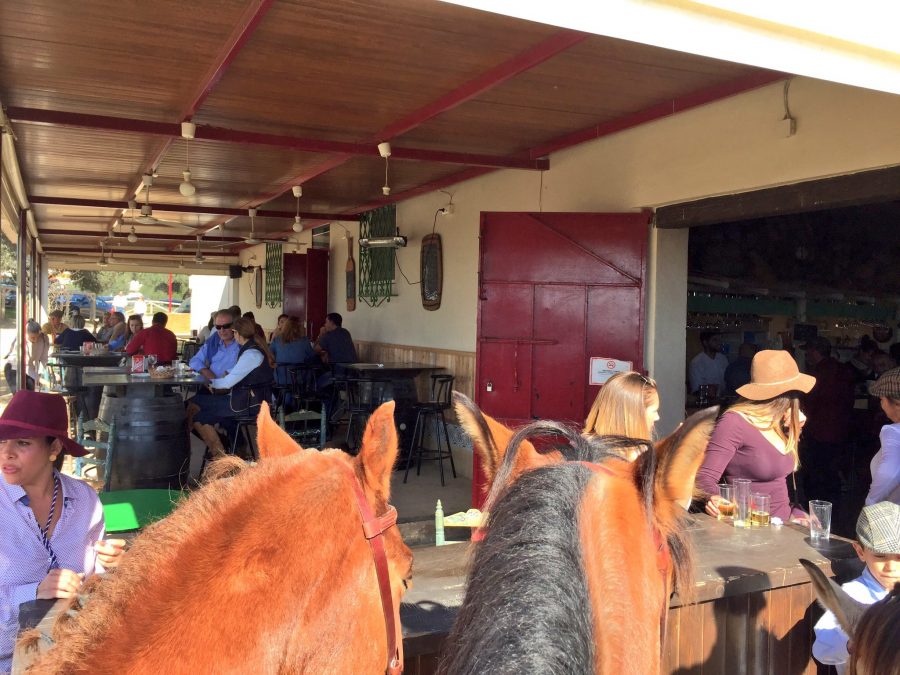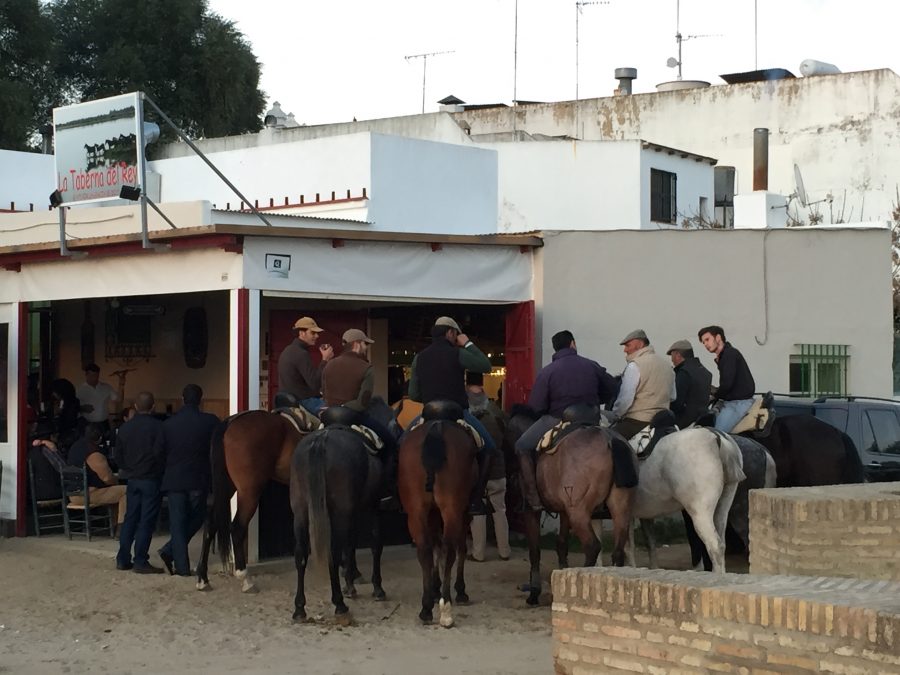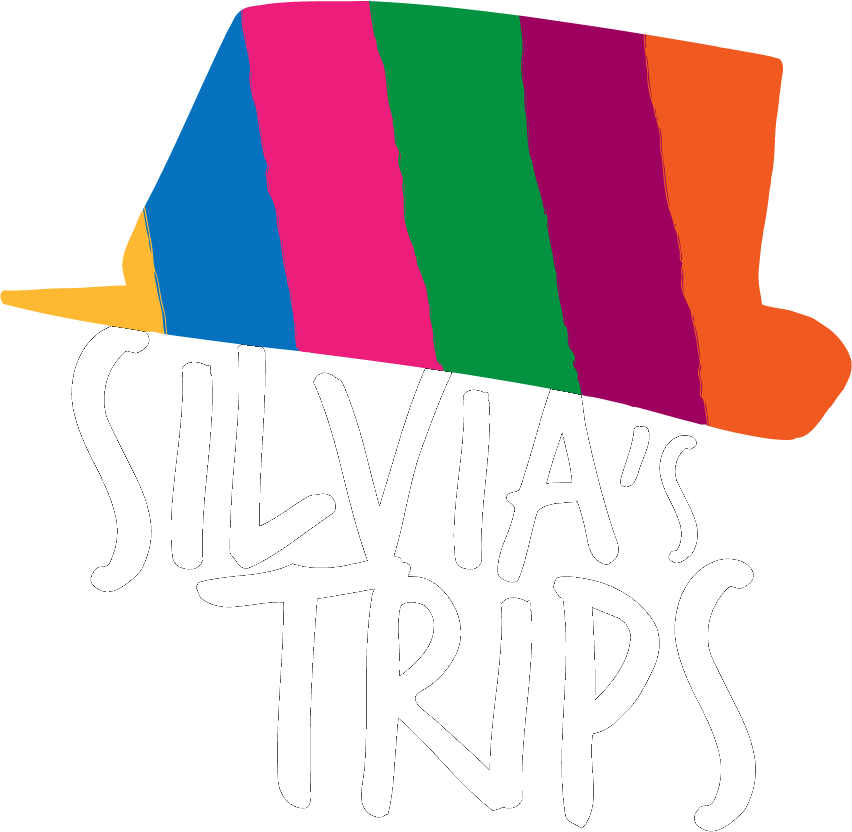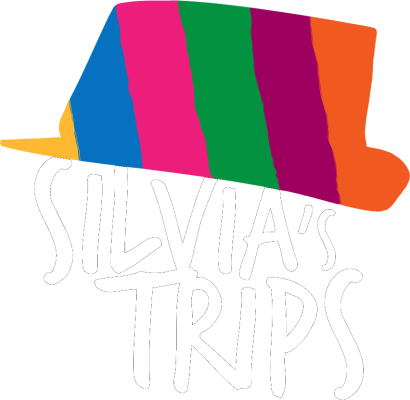El Rocío is different. It’s like a small parallel world in the heart of Andalusia, and I deeply love it!
I postponed this post for years because I’m jealous of this village. I know it’s silly, but when you fall in love with a place, and it becomes your refuge to refuel, you’d want it to stay the same.
El Rocío is a dusty small village, the end of the road from Seville and in the other direction from the Portuguese border. A road that sees thousands of pilgrims riding or walking or driving to town to worship the Blanca Paloma (i.e., White Dove) in a massive pilgrimage.
My brother moved there almost by mistake. He was driving to Conil de la Frontera and stopped in El Rocío for the night. When he woke up the following morning, he realized he had ended up in an almost surreal place and decided to stay much longer!
In his first messages, he started sending me pictures of a lovely village that looked like a Western movie set and then a short video of stunning horses all around, and I thought, “This must be the place.”
This is my fifth year flying there as soon as possible to relax and escape reality.
About El Rocío
El Rocío is part of the municipality of Almonte, just a quick drive away. It is one of the most charming places in the province of Huelva, which I would recommend anyway.
Marshes and swamps surround the village, and it is the main door to the Doñana National Park. It’s a small world where horses have priority over everything else; religious ardour keeps impressing me, you can smell candles everywhere, streets are sandy – and a bit dusty – where pretty tiny white houses follow each other. Brotherhood headquarters stand at every corner, where cowboy boots and Seville-style sensual dresses colour and enhance the atmosphere, beer costs nothing, and guitars play night and day during weekends…






Sightseeing in El Rocío is worth it, even if you’re neither a horse person nor a religious one.
What to see in El Rocío
First, I recommend you slowly walk from one sandy alley to the other, enjoying every pretty house’s tiny detail, the public horse training spaces scattered around, and incredible people having a cold beer at the counter on horseback!
Do enter some souvenir shops around the church. They sell souvenirs related to the pilgrimage, the latest flamenco outfits, and horse riding accessories.
Hermitage of El Rocío
The first visit should be to the shiny white Hermitage of El Rocío, a monumental cathedral conceived as an Andalusian farmhouse topped by a locksmith cross. Built between 1963 and 1969 on the main square, it attracts more than one million visitors yearly.
The impressive baroque-style altarpiece houses the most revered image of all Andalusia: the White Dove, Our Lady of Rocío, the town patron. It was sculpted at the end of the 13th century, originally in Gothic style. It was destroyed during the Lisbon earthquake in 1755 and rebuilt again in 1969. She is dressed in rich fabrics, following the Austrian court fashion.




They even built a candle room across the street, where people lined up to light the wax candles bought at the next-door kiosk. It’s impressive: thousands of candles, that light, smell, and dyed black ceiling and walls, and that religious fervour. I’m agnostic, but I always found this place touching.
The City Hall
The City Hall was once a Dominican convent on the Virgen del Rocío square. The facade shows the coat of arms of the Medina Sidonia.
Church of the Assumption
It’s a 15th-century parish church on the Plaza del Rocío, rebuilt in the 17th century in the Baroque style, which is the predominant style.
Marismillas Palace
Located in the heart of the village, this palace is the favourite holiday residence of the presidents of the Spanish government and foreign Heads of State visiting Andalusia.
Plaza del Acebuchal
It’s the square surrounded by cool bars and restaurants and pretty hotels, presided over by a centennial wild olive tree of impressive proportions. Well, there are several others around it that I find huge!



Puente del Ajolí
Before entering the village, you cross the Ajoli Bridge, or Puente del Rey, where pilgrims traditionally gather to sing along to the Simpecados during the Camino.
On the pavement, you can see the plates with the names of the different Brotherhoods that cross it on their pilgrimage to the Blanca Paloma.
The Paseo Marismeño
The Swamps Walk starts before the Hermitage and ends almost at the forest’s Camino de la “Raya Real” entrance.
You will receive signs with pictures and descriptions throughout your bird-watching experience, as El Rocío is home to many different species and beautiful flamingos.
Francisco Bernis Bird Observation Center
If flora and fauna are your passion, you can visit the Francisco Bernis Bird Observation Center 350 meters east of the Hermitage of El Rocío on the Paseo Marismeño.
The centre—closed on Monday—will provide you with plenty of helpful information and even high-quality binoculars to observe the park’s species.

Horses in El Rocío
As I told you, horses are the priority here, and this is why I love this place, which has been named Aldea Internacional del Caballo (i.e., International Horse Village) since 1992.
Upon entering the village, you immediately realise that alleys and squares are sandy paths where horses and horse-drawn carriages move freely and effortlessly.
On each side, lovely white houses line up, with pretty flowery balconies supported by cast-iron columns, courtyards, and beams to secure horses.
Bars and taverns have outdoor tables at the appropriate height for riders to enjoy their beers and meals without getting off the horse.
To me, this is an idea of paradise. Unless you don’t like horses, I recommend a ride to the entrance of the Doñana National Park, along the pilgrim’s “Raya Real” Road, passing through the pine forest known as “El Chaparral” to the Vado del Quema. It is a relaxing and fantastic experience, allowing you to see deer and other wild animals.





You can book a tour at the Info Tourist Office downtown or your hotel front desk.
Saca de las Yeguas
A horse-related, impressive, centuries-old traditional event is the Saca de las Yeguas (i.e., Take out the Mares), scheduled every year at the end of June.
During the weekend, ranchers gather mares and foals of the wild herds in the Doñana marshes and take them to Almonte through El Rocío. There, they mark the foals and trim their mane and tail. Some are sold, but most are returned to the marshes.

La Romería de El Rocío
The famous massive pilgrimage occurs every year on the Monday following Pentecost (50 days after Holy Saturday).
The peak of the celebration is on early Sunday morning, after the parade of endless carriages adorned with flowers when camps are lit with candles and torches, and believers drink, sing, and dance to the rhythm of tambourines and flamenco guitars.
Pilgrims reach the village on horseback and carriages through four different caminos: the Sanlúcar road from Cádiz, crossing the Doñana National Park, the Plains from Almonte, the road of Moguer from Huelva, and the Sevillian road.
Every seven years, on the night of August 19 to 20, the Blanca Paloma is carried on shoulders along the 15 km road of the Plains, between pine and sand, to the Church of the Assumption in Almonte. To make this journey, the Virgin abandons the Queen’s usual dress for “Pastora,” the travel suit used in the 17th century.
The White Dove returns to the village nine months later, a week before the pilgrimage, when almost a million pilgrims move to El Rocío.

This tradition, dating from 1813, thanks the Virgin for ridding Almonte of French troops during the Napoleonic invasion. The next one is in 2020!
Parque Nacional de Doñana
Besides the pilgrimage, one of the main attractions of El Rocío is the Doñana National Park: beautiful lagoons, dunes, swamps, weeds, wild animals – such as the Iberian lynx – and 27 km of virgin sandy beaches.
The park was established in 1969 and then enlarged. In 1994, UNESCO declared it a World Heritage Site and became a Biosphere Reserve.



You can access it only by joining a guided tour. Several options exist, from the classic group tour to the private ones. No matter which one you select, I recommend you book well ahead!
Where to sleep
I can recommend two different accommodations in town: el Pequeño Rocío, right outside the village, and the Hotel La Malvasía, an old manor house right downtown with its own stables.
The first option is a big hotel with rooms and apartments of several sizes. The first time there, I rented a two-floor apartment with my dad, which was tremendous and convenient. Their breakfast is quite basic, but dinner is always excellent!


The second one is more intimate and romantic, having you feel part of local traditions and mood. Plus, it’s right in front of one of the many public equestrian fields, and you can spend hours admiring stunning Andalusian horses warming up or training.
Where and what to eat
Local food is typical Andalusian, but I recommend prawns, lobsters, and seafood. My beloved soups are the goose-based Sopa Marismeña, the Sopeao (which has the same ingredients as gazpacho), and the local Almonte stew. In El Rocío you can even taste alfajores with dulce de leche!
Restaurants and bars are scattered all around the village, and they more or less offer the same menu but at different levels… here are those I recommend:
Restaurante Toruño is on the Plaza del Acebuchal and has beautiful stained glass windows with marsh views.
Restaurante Cristina has tables outside and a good choice of grilled meats and seafood. Their soups are excellent!





La Taberna del Rey is perfect for a pit stop on horseback. Their sandwiches are yummy, and they serve a good lager beer.
Bar La Garrocha, on the main square, is also a good option for a quick drink or tapas.
Restaurante Aires de Doñana, on the other side of the marsh, with views of the marsh and the hermitage.
GHermitageere
There are regular buses from both Seville and Huelva. From Sevilla, you get direct buses (one hour), but from Huelva, you have to take a bus to Almonte (just over an hour) and then from Almonte to El Rocío (about twenty minutes). The whole trip costs less than € 10 with Damas.
Day trips and visits around El Rocío
A short drive or bus ride from El Rocío has plenty of sightseeing options, from Palos de la Frontera to Almonte to never-ending golden beaches and, of course, Seville and Huelva…
Almonte is a small town with a pretty historic centre and the interesting Museo de El Rocío that should be visited before visiting the Parque Natural de Doñana.
Scattered all along the Huelva coastline are eleven watch towers, designed by Felipe II and completed by Felipe IV, to protect the coast from pirate attacks. Five are under the Almonte local administration: Torre de la Higuera in Matalascañas (an inverted tower collapsed into the sea centuries ago), Torre del Asperillo in Castilla, and Torres de San Jacinto, Carboneras, and Zalabar in the Doñana National Park.





If you are a beach person, this is also a perfect destination, as, in a few minutes, you can reach beautiful sandy beaches. Matalascañas is ideal for long walks on the waterfront, surfing, or relaxing and enjoying its dunes and pine forests; Castilla is reserved as a nudist beach, as is Mazagón.
Close by is the Dunar Park of Matalascañas, near the beaches, with its Marine World Museum.









